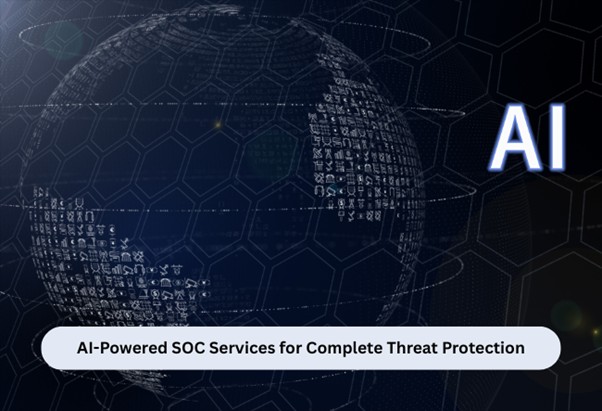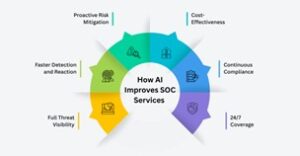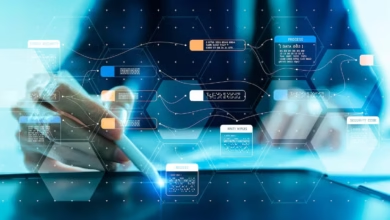Transform Your Security Posture With AI-Powered SOC Services Designed For Complete Threat Visibility And Protection

We are going through a time where cyber threats are changing at lightning-fast speed. Companies must go beyond traditional security measures and use intelligence-driven defence strategies. Firewalls and antivirus tools can’t protect against advanced attacks on their own anymore.
This is where an AI-powered SOC service is very important. A modern SOC gives you full visibility into your security landscape by using advanced automation, threat intelligence and human expertise. It can help you to find, analyse, and neutralise threats in real time.
A well-run SOC not only helps find active attacks, but it also predicts possible breaches before they happen and changes reactive defence into proactive resilience.
What is a SOC Service & Why Does it Matter
Before we talk about how AI can improve a SOC’s abilities, we need to know what a SOC service is.
The Security Operations Centre (SOC) is the main control centre for an organisation’s cybersecurity system. It keeps an eye on networks, endpoints, servers and cloud assets all the time to find and deal with possible threats.
When this service is delivered as a managed SOC, it becomes even more powerful because it provides expert monitoring and response 24/7 without the need to build or maintain your own security system. This mix of managed expertise and AI-driven technology helps businesses of all sizes improve their cyber resilience in a way that is both effective and efficient.
How AI Enhances SOC Services
AI has changed the way SOC services work in a major way. Modern SOCs use machine learning, behavioural analytics and automated orchestration instead of checking thousands of alerts and logs. This helps them stay one step ahead of attackers.
Take a look at how AI changes traditional security operations into smart cyber defence:
Smart Threat Detection
AI looks at huge amounts of network traffic and system logs to detect small anomalies that could mean hidden attacks.
AI learns from patterns, so it can find new and changing threats like zero-day exploits or insider activity. This is different from static rule-based systems.
Predictive Analysis
AI can figure out possible attack paths before they are used. This is done by linking global threat intelligence with internal activity data. This ability to predict lets security teams focus on the most dangerous vulnerabilities and protect important assets before they are attacked.
Automated Response to Incidents
SOAR (Security Orchestration, Automation, and Response) platforms that use AI can automate tasks that need to be done over and over. These tasks could be alert inspection, containment and ticketing. This reduces the average time it takes to find and respond to incidents by a lot.
Continuous Learning and Optimization
Every new incident helps make AI models better, which makes them better at detecting things and cuts the number of false positives. The end result is a SOC that learns and improves on its own as new threats come up.
AI and automation work together to turn a managed SOC from reactive monitoring into intelligent and adaptive defence.
Key Components of an AI-Powered Managed SOC
Before talking about the benefits, it’s helpful to know what makes an AI-powered Managed SOC so useful. Together, these elements provide full visibility and a quick response.
Security Information and Event Management (SIEM)
Collects log data from many places like networks, endpoints, and cloud systems. It then uses correlation rules and AI analytics to find possible threats.
Threat Intelligence Platforms (TIP)
Collect and combine threat data from around the world to help analysts spot known attack patterns and indicators of compromise (IoCs).
Security Orchestration, Automation, and Response (SOAR)
Automates workflows, which makes it possible to respond to security incidents more quickly and consistently.
Endpoint Detection and Response (EDR)
Lets you see how endpoints are acting and finds suspicious processes and possible intrusions in real time.
Human Expertise
Even with automation, expert analysts are still very important for understanding alerts, linking up complex attacks and making smart security choices that machines can’t do on their own.
The SOC’s main goal is to monitor, contain and protect threats in real time. Each of the above components help with that.
Benefits of an AI-Powered SOC Service

AI-driven SOCs aren’t just about finding threats faster. They also show a move towards smarter, more self-sufficient defence operations. Let’s look at a few benefits of the AI powered SOC service:
Full Threat Visibility
AI-powered SOCs keep an eye on every part of your IT infrastructure all the time. They give you a single view of both on-premises and cloud environments.
Faster Detection and Reaction
The SOC greatly speeds up detection and response times by automating repetitive tasks and linking threat data. This cuts down on possible damage.
Proactive Risk Mitigation
AI-driven predictive analytics help find and fix possible weaknesses before attackers can use them.
Cost-Effectiveness
A managed SOC gives you high-end protection without the costs of hiring, training and keeping an in-house SOC.
Continuous Compliance
Automated reporting and audit-ready documents make sure that standards like ISO 27001, SOC 2, and GDPR are always followed.
24/7 Coverage
AI never sleeps, and neither does a managed SOC. Organisations are always safe from cyber threats thanks to constant monitoring and human supervision.
Challenges in Implementing a SOC Service
Even the most advanced SOC service has its own challenges and organizations must tread carefully. Take a look at a few of the challenges that come with it:
1.Data Overload
Thousands of alerts might be generated daily and it can be really hard to differentiate between the false positives and real threats. AI can help reduce this burden through correlation and prioritization.
2.Integration Complexity
Merging different tools with logs and systems into a single monitoring system requires careful planning and expertise.
3.Talent Shortage
Cybersecurity experts are in short supply. But a managed SOC can help bridge this gap by providing access to experts and analysts.
If you can address these challenges, you can be assured that your SOC investment will translate into better security.
Next Steps
If your business is having trouble with alert fatigue or the rising costs of cybersecurity operations, a managed SOC might be the best thing to do next.
Before choosing a provider, think about the following:
- Proven use of AI and automation in detection and response.
- Clear reporting and compliance alignment
- Analysts who are good at understanding the context and responding
There are good firms like who are known in the industry for giving AI-powered SOC services. They combine real-time CyberNX monitoring and expert analysis and protect businesses from cyber threats.
Conclusion
Cyber threats are getting faster, smarter, and harder to get rid of. To fight them, businesses need a defence that is smart and can change. A modern managed SOC keeps your business one step ahead every hour, every day with the help of automation, analytics, and expert human oversight.


